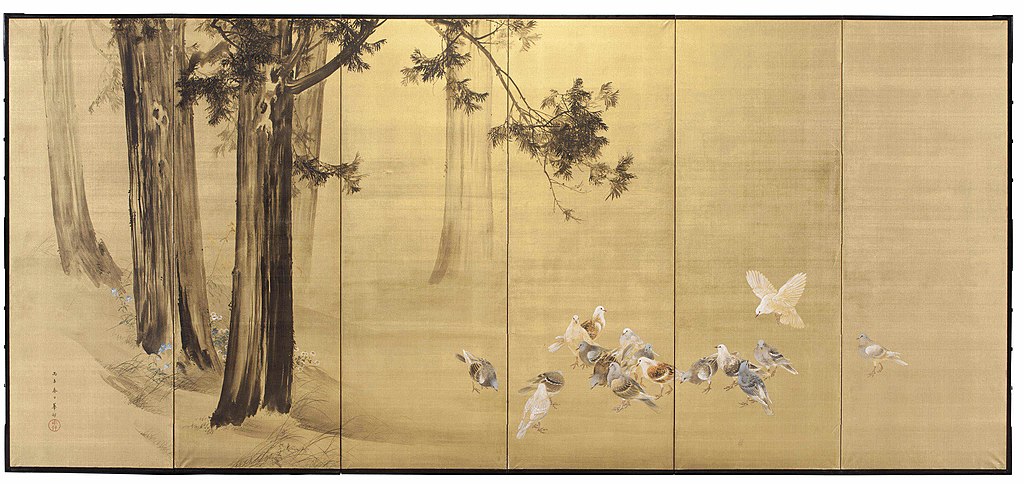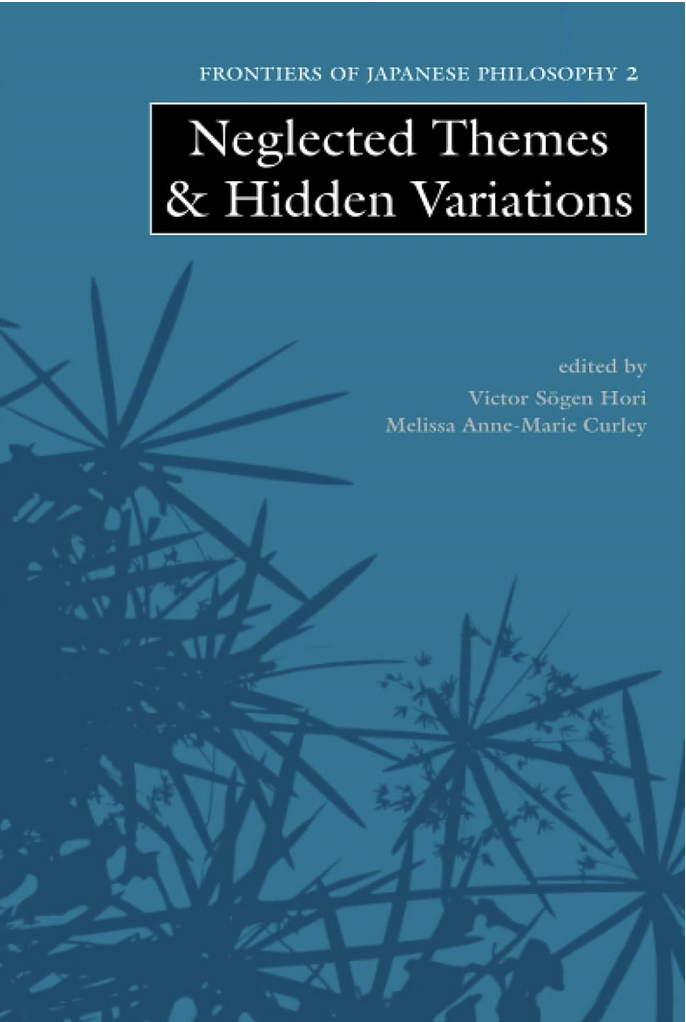
“Non- or de-mysticism involves a double negation, a release from the ego and then from God. God is let go of for the sake of nothing, that is, for an experience of absolute nothingness, which in turn returns us to a direct engagement in the here and now of everyday activity” (Bret W. Davis)
Nishida: “Zen has nothing to do with mysticism”
Nishida stated quite provocatively: “Zen has nothing to do with mysticism, as many think. Kensho, seeing one’s nature, means to penetrate to the roots of one’s own self. The self exists as the absolute’s own self-negation. We exist as the many through the self-negation of the One … Kensho means to penetrate to the bottomlessly contradictory existence of one’s own self … What has been called mysticism in Western philosophy since Plotinus is something extremely close to Zen, but I think that Western mysticism has not in essence transcended the standpoint of object logic. Indeed, the One of Plotinus stands at an opposite pole to the Zen experience of nothingness. Neo-Platonism did not in fact attain to a religious celebration of the ordinary and everyday as we find it in the Zen tradition” (Nishida, Last Writings, 108-109).
Bringing with him a new understanding of mysticism from his study of Meister Eckhart as he revisited Nishida’s assertion, Ueda undertook to clarify how Eckhart’s mystical experience and the Zen kensho relate to each other as stages in a self-emptying thrust beyond God as creator, and into absolute nothingness, which he shows goes to full completion in kensho, as it is followed by “a return to an … engagement in the here and now.” The entire dynamic “from union to ekstasis,” he calls “non-mysticism.” “The point here is that non-mysticism is not a state to achieve, it is a dynamic, the activity of self-emptying.” I will follow Bret W. Davis’ essay, “Letting Go of God for Nothing – Ueda Shizuteru’s Non-Mysticism and the Question of Ethics in Zen Buddhism,” (Frontiers of Japanese Philosophy Vol 2, 221-250), though only a few glimpses into this thirty page paper can be given here.

Non-mysticism as a the “entire dynamic ‘from union to ekstasis’”
Because Ueda sees non-mysticism as an ecstatic thrust, Davis suggested that the word, which is a translation of Nicht-Mystik, could be replaced by Ent-Mystik – in English, “de-mysticism”- as the German prefix “Ent” can refer both to the development of a potential and to an undoing or removal of a burden: Ent-Mystik would then be an actualisation which is at the same time a release. The word “non-mysticism” is now used for Ueda’s view in English.
Davis writes: “Non- or de-mysticism involves a double negation, a release from the ego and then from God. God is let go of for the sake of nothing, that is, for an experience of absolute nothingness, which in turn returns us to a direct engagement in the here and now of everyday activity” (222-23).
Christian mysticism is traditionally understood as a surrender of one’s self through union with a God conceived of as Creator. Since God is seen as a Being, such a surrender is lived as the dissolution of one’s small self into the larger, higher, truer Divine Self. Eckhart, however, understands the truly Divine as transcending creation itself, or, rather as being the ground of creation, which he calls the Godhead (Gottheit). He refers to it as the “impersonal essence of divinity,” and also as nothingness. But, Davis says, “this absolute nothingness is not an apophatic indicator of an ineffably transcendent Godhead beyond God; it is not a negative theological sign for something ‘wholly Other’ that lies “beyond Being.” Rather, Davis says “Ueda understands absolute nothingness dynamically as ‘the activity of emptying out’ (kukai no hataraki), that is, as the ecstatic movement of de-mysticism itself.” (224-25). This is what Dogen refers to when he says that “body and mind are dropped off.” And this dropping off marks an embrace and affirmation of all things in their unique concrete actuality, their “suchness.”
Whereas Ueda had “provisionally divide[d] the entire dynamic of “from union to eksasis” into two segments,” Davis goes further and divides the movement into four moments, a move Ueda agreed to, as follows: “1) an ecstatic transcendence of the ego; 2) a mystical union with God or the One; 3) an ecstatic breakthrough beyond God or the One into an absolute nothingness; 4) a return to an ecstatic/instatic engagement in the here and now” (223). The ecstatic realisation of no-self as true self allows the “instatic” engagement in the here and now.
Mysticism proper covers the first two stages, non-mysticism the two last stages, but the same thrust of self-emptying is operating as a continuous movement throughout.
Davis describes the process of non-mysticism as “a series of ecstasies.” “Ecstasy – in the strict sense of ek-stasis, literally a ‘standing outside oneself’, which implies, as the Japanese term ‘datsuji’ literally means, a ‘shedding of the (ego) self’ – is an initial prerequisite for the mystical union” (224). The fundamental difference between the way Christianity and Zen understand ecstasy is that, for Christianity it is a sort of one-off surrender, almost a substitution of the Divine Self to the small personal self, whereas for Zen it is the on-going activity of self-emptying.
Though it is not incorrect to contrast East and West in terms of a concept of ultimate reality as emptiness for the East, and a concept of ultimate reality as being for the West, another, perhaps more fundamental difference is overlooked: that between an Eastern concept of reality as dynamic, and a Western concept of reality as a “solid” rational system embodied in substance. Reality as dynamic sees the world as fundamentally “alive,” forever expressing itself through new phenomenal forms, whereas reality as a solid rational system leads to a wish to forever stifle its creativity through control.
Emptiness as “self-emptying”
Ueda’s assertion of non-mysticism as true mysticism, that is, a dynamic rather than a state, follows rather closely Nishitani’s description of emptiness as a self-emptying. In Religion and Nothingness, Nishitani mentions an incorrect understanding common in Buddhism called “‘life inside the Black Mountain’ or ‘living in the Demon’s Cavern’. One is holed up inside the cave of the self-conscious ego that has nothingness at its ground. And as long as this nothingness is still set up as something called nothingness-at-the-bottom-of-the-self, it remains what Buddhism repudiates as ‘the emptiness perversely clung to’” (Religion and Nothingness, 33). This was the error at the core of Sartre’s “néant” which, in Nishitani’s view, was a nothingness-at-the-bottom-of-the-self, and it is a pervasive misconception among beginners just starting a Buddhist practice. Emptiness is not a “thing,” it is a process of self-emptying. Nishitani writes: “Emptiness in the sense of sunyata is emptiness only when it empties itself even of the standpoint that represents is as some ‘thing’ that is emptiness. It is, in its original Form, self-emptying” (RN 96), before coming up with the striking formula, “The point at which emptiness is emptied to become true emptiness is the very point at which each and every thing becomes manifest in possession of its own suchness” (RN, 106). The Great Doubt is not just an exercise to attain the state of emptiness, it is itself the activity of self-emptying which is what emptiness really is – a dynamic self-emptying. Ueda returns to that dynamic self-emptying and translates it as a breakthrough from mysticism to non-mysticism, which is true mysticism.
The dropped-off ecstatic life is not, however, described as a life “above all earthly joys, above all delights, above all consolations, and still more than that” as Teresa of Avila describes it, or as Satchitanda’s “sat, chi, ananda,” that is, “existence (or truth), consciousness, and bliss,” as the Vedanta sees it. It is more humbly described as “living an ordinary life,” which involves not just an acceptance of the ordinariness of everyday life, the so-called “chopping wood and carrying water,” but perhaps more importantly the willingness to foresake the comfortable routines to embrace the issues of the day. These too, are part of an ordinary life, though we must beware of getting caught up in a wish to improve the world without considering that much of what is done to improve reality is in fact damaging it.
Mary and Martha – the vita activa as closer to God than the vita contemplativa
Davis further notes that Ueda takes it as evidence that Eckhart had a Zen-like insight into an equation between the ecstatic life and a life of action, when he reversed the traditional interpretation of the stories of Mary and Martha. He writes: “Eckhart does not stop at a contemplative absorption in a mystical nothingness. In his account of the story of Mary and Martha (Luke 10:38-42), Eckhart reverses the traditional interpretation – which uses the story to assert the preeminence of the vita contemplativa of Mary over the vita activa of Martha – to claim that Martha’s activity, ‘busy about many things’, is in fact a profounder expression of union with God than the passivity of Mary, who remains seated at Jesus’ feet. Martha’s business expresses the ‘pure activity’ (luter würken) which comes directly out of God. More radically put, the life of this pure activity might be said to arise ‘without why’ out of the silent desert of absolute nothingness” (227).
To be sure, Eckhart himself was not a recluse, spending his days and nights in contemplation. He held positions of responsibility as Prior and Provincial, at one point being responsible for overseeing forty-seven convents in Saxony. He also taught at the Sorbonne in Paris. He was as actively engaged in the history of his time as one could be, and that, in fact, led him to being accused of heresy. His “crime” had been to teach to ordinary members of congregations that God had become human in Jesus so that humans could realise divinity, in the Buddhist sense of attaining enlightenment. And it was a crime because it was held that ordinary people would take this to mean that they could “be” God. The Church did not notice, or accept, that Eckhart had placed the Godhead of nothingness “above” God as Creator. It was not prepared for such an understanding of God.
It is ironic that the figure whom Nishitani took as having gone closest to an understanding of the “None beyond the One,” and Ueda as having gone farthest in the self-emptying thrust of non-mysticism, is one who was challenged by the Church, not condemned (Eckhart died before the trial!), yet caused to have his intellectual legacy transmitted under the cover of secrecy for centuries. Though he is said to have been de facto recognised as “innocent,” Meister Eckhart has never been officially, publicly, rehabilited by the Church. The very attention Japanese religious philosophers have paid to him, may be taken to be his true rehabilitation, and more …
“Unlike Zen [Eckhart] does not let go of God so as to simply affirm the suchness of natural phenomena”
Yet, even though Eckhart’s mysticism has a world-affirming quality that the life-denying mysticism of many Christian mystics lacks, his affirmation is more an affirmation of things as God-infused than as things as they are in their suchness. Davis says that “this is because Eckhart’s metaphysics begins and ends with the Godhead as a trans-wordly source and eschatological end of the created world. The path of Zen, on the other hand, begins and ends with the everyday world. Life in the midst of the nondual multiplicity of the world is affirmatively engaged in by way of passing through and beyond the One, as opposed to the world being affirmed as an outflow of and pathway back to the Godhead” (234). Eckhart’s mysticism still belongs to a dualistic metaphysics of transcendence, where transcendence defines itself as the opposite of immanence, and “superior” to immanence, while Zen belongs to a non-dualistic sense of the immanence of all things, which includes transcendence.
Davis continues: “To begin with, Eckhart’s sole concern is said to be with the soul’s relation to God, and he pays little attention to the world of nature, whereas for Zen, natural phenomena express the very concrescence of the non-egoity of the true self … “Unlike Zen [Eckhart] does not let go of God so as to simply affirm the suchness of natural phenomena, that is, things such as they present themselves as they are within nothing but the empty expanse of absolute nothingness. Quoting Eckhart as saying: ‘To one who looks at a stick in the divine light, the stick looks like an angel’, Ueda writes: ‘Eckhart’s affirmation of the stick is not an affirmation of the stick as a stick, but of the stick as an angel in divine light. Zen Buddhism speaks more straightforwardly: ‘Mountain as mountain; water as water’…”(235).
Seeing mountains and waters as “lined with nothingness,” as Robert Carter describes them, and regarded as real in their phenomenality (see Self-contradictory Identity – the Logic of Soku, in the Nishida section), is not the same as seing them as “haloed by divine light,” because in the latter case, mountains and waters are not seen as real as they are in themselves as concrete and unique phenomena in our experience of the present moment. Instead they have received their reality from a “trans-worlly” dimension, and this, as such, implies that as mere “worldly” phenomena, mountains and waters are not quite real. So Eckhart’s mystical journey could not end up with a reaffirmation of “the ordinary” and, in fact, amounts to a celebration of a nothingness which is even higher than God himself. Only within a grasp of reality as “form is emptiness, emptiness is form,” can one see the ordinary as the expression of emptiness, the many as the negation of the One, through the dynamic of self-emptying.
Davis quotes Ueda’s conclusion: “In the final analysis, Ueda concludes, Eckhart’s ‘nothingness’ remains a negative theological sign pointing towards an inexpressibly higher Being: “In the case of Eckhart, because of the excellence of the suprabeing (Uberwesen) of God’s being, it is called nothingness.” When all is said and done, Eckhart’s nothingness of the absolute (zettai no mu) is an adjective modifying a substance. In contrast, Zen’s nothingness (zettai mu) is a verb referring to “the activity of emptying out (kukai no hataraki)” (236).
I cannot end this page without mentioning James W. Heisig’s statement in “Introduction to Ueda’s Works,” the chapter he contributed to the Tetsugaku Companion to Ueda Shizuteru, where he says: “The initial struggle to defend the distinction between the “mysticism” of Eckhart and the “non-mysticism” of Zen ended with Ueda recognizing a “non-mysticism” that Eckhart himself achieved by breaking through “mysticism.” Heisig and Ueda had a twenty- year-long friendly as well as professional relationship, as they collaborated in the creation of the Ueda Shizuteru Shu (The Ueda Shizuteru Collection). The above statement is in volume 8 of the Collection.
Sources:
Nishida Kitaro – “The Logic of the Place of Nothingness and the Religious Worldview” in Last Writings
Bret W. Davis – “Letting Go of God for Nothing – Ueda Shizuteru’s Non-Mysticism and the Question of Ethics in Zen Buddhism,” (Frontiers of Japanese Philosophy Vol 2, 221-250)
Nishitani Keiji – Religion and Nothingness
James W. Heisig – “Introduction to Ueda’s Works” in Tetsugaku Companion to Ueda Shizuteru, Ed. Ralf Müller, Raquel Bouso and Adam Loughnane (2022)

